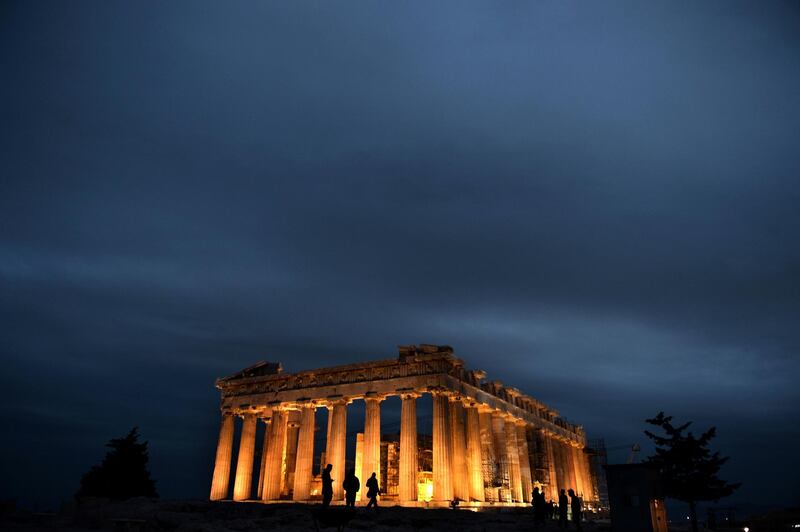The rich history of Greece's capital occupies the minds of classical scholars and those who cherish democracy, but the reality of the city doesn't quite match up.
"Serene" is not a word you’d use to describe Athens, where scooters hurtle down cramped alleys and street artists turn semi-abandoned buildings into canvasses. It’s grittily energetic, but interspersed with staggering reminders of the past. Streets buzzing with nightlife can suddenly give way to millennia-old ruins, discovered when digging out a metro station or building foundations. And those jolting surprises are the source of Athens’s appeal.
7.30am: A walk in the park
There are a few ancient remnants to be found in the National Garden, which spans 15.5 hectares from the back of the Parliament building. Admire trees from around the world, turtles in the ponds, and soak up the peaceful greenery on a morning stroll. It's likely to be the last dose of serenity for the day.
8am: Olympian feat
At the southern end of the park stands the remarkable Panathenaic Stadium, a hulking great 60,000-capacity horseshoe of marble. It was the host venue for the first modern Olympics in 1896, and is where the Athens marathon finishes every year. More importantly, it looks like no other stadium on Earth and feels like a remnant of ancient Greece rather than a modern construction.
9am: Head up the hill
Want real ancient Greece? Then the Acropolis plays host to a cluster of some of the most important – and impressive – classical sites on Earth. The Parthenon, designed as a perfect jigsaw puzzle with every element individually shaped, sized and curved to fit the ideal sightlines of the human eye, is usually billed as the star here, but there is so much more on the way. There’s the Theatre of Dionysus, where the art of drama was born, and the Odeon – a 5,000-seater open-air theatre from the Roman era, which is now used for outdoor concerts in the summer.
The Acropolis is one of those places for which a good guide is worth the investment. Someone with knowledge, who can bring the ancient temples to life, and explain exactly what every building was used for and why it's there, is invaluable. The three-hour Acropolis tour from Context Travel, €85 (Dh367) provides this in huge, constantly surprising doses.
11.00am: A deeper understanding
The tour finishes at the New Acropolis Museum, which could have been just a depository for old relics, but manages to be so much more. It is divided into eras, showing how artistic and sculptural techniques have changed as the Greek capital evolved.
The top floor, designed to be the same size and orientation as the Parthenon, is the crowning glory. Some remaining original marble metopes, plus some reconstructions, are assembled exactly how they were, with the stories of gods and mortals told on them explained on panels below.
13.00am: Diamond in the rough
The Plaka area at the foot of the Acropolis is extremely touristy and brimming with mediocre restaurants. Arcadia is a happy exception to the rule here – the “authentic” and “traditional” labels are genuine rather than just a cynical bait. The cod fish fillet for €13.50 (Dh58) is a solid bet.
2.30pm: Into the heart
If the Acropolis was the head of classical Athens – the preserve of the priests and VIPs – then the Agora was where real life happened. The excavations across the site have uncovered the ruins of temples, markets, libraries and theatres.
No single building is a standout, and that’s rather the point – the strength of the Agora as a visitors’ attraction is that it gives an idea of how classical Athens all fitted together.
4pm: Switch ancient for modern
Athens isn't all about old bits of stone, though. And to the north of the Agora is the Psirri neighbourhood, which offers a completely different vibe. This part of the city offers up dozens of cafes, restaurants and terrace hangouts, plus a magnificent collection of street art.
Urban Adventures runs Bohemian Tales of the City walking tours that focus on Psirri’s backstreets and courtyards, showing off arts organisations and the best murals, before moving on to Gazi. Here, a former gasworks has been turned into a hip nightlife, concerts and events space, transforming the once grim surrounding area. The tour costs €70 (Dh300).
8pm: Food with a view
Hidden away in the Monastiraki flea market, Cafe Avissinia is lovingly eclectic downstairs, with paintings all over the walls, stained glass windows and a piano in the corner. But ignore that and head straight upstairs to the rooftop, where the terrace has picture-perfect views of the Acropolis. The menu deliberately focuses on specialist regional dishes, such as the €10.50 (Dh45) soutzoukakia – a traditional meatball favourite from what is now Izmir in Turkey.
Rest your head
The Hera in Plaka is a discerningly classy affair, and incredibly good value for from €72 (Dh309) per night.
The lobby is all stained glass ceiling and rich wood panelling, while upstairs, you’ll get plumply padded headboards as well as lavish and luxurious green marble bathrooms.
Getting there
Emirates and Etihad fly directly to Athens from Dubai and Abu Dhabi respectively. Economy returns cost from Dh2,445.
______________________
Read more about Greece:
Mykonos: peaceful pursuits on a five -star party island
Santorini on a budget: How to make your euro go further
Where to eat, sleep and shop in Thessaloniki, Greece
______________________





